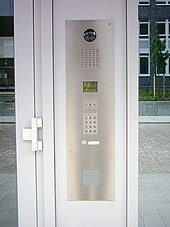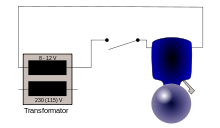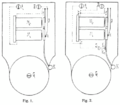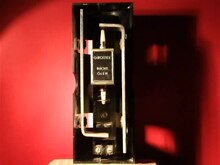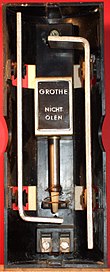bell

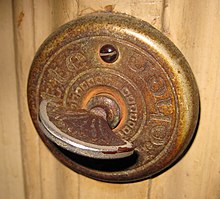

A bell is an acoustic signaling device , consisting of an oscillating body (e.g. bell ) and a hammer to stimulate the oscillation . The task of a bell is to attract the attention of the addressee through the ring tone, so the bell is often part of an intercom system . Although, in contrast to bells, ringing is not stimulated by single strikes but several times to a continuous tone, it is still sometimes referred to as a bell. Electronic bells, such as melody bells, are also referred to as bells.
The derived term ringing is also used for acoustic signals that are no longer generated by actual ringing, in particular telephones ( ring tones ), electronic alarm clocks and electronic doorbells. For people with hearing impairments , the bell can also be combined with a light signal, and models with a vibrating alarm that can be carried in the pocket are also available for radio-controlled bells .
Mechanical bells
- door bell
- Mechanical doorbells are rarely found in the 21st century . They were once operated by knobs or cables and were an alternative to door knockers .
- Internal ringing with a bell
- Winding alarm clock
- Bicycle bell
- The tram bell , initially operated mechanically as a departure signal (usually by the conductor ), is now given electrically by the driver.
- Shop bell. Mechan. Signal when opening a (shop) door. See also pass-through detector
Electromechanical bells
Electromechanical bells with a continuous drive work with a Wagner hammer or with a swing armature . The Wagner hammer is suitable for direct and alternating current, but causes radio interference and excess voltage due to the switching processes during operation , while the oscillating armature version only works with alternating current, but is completely free of radio interference . For safety reasons, bells in the home are usually operated with harmless low voltage , which is generated by a bell transformer . An alternative is the use of batteries , which only emit direct current and are therefore not suitable for ringing bells with a vibrating armature.
For versions without continuous drive (gongs) see below .
- Front doorbell: The doorbell is a bell whose button (trigger) is attached next to a door so that people can make themselves known. The bell itself is usually in the apartment. Today doorbell systems are very often combined with electronic door openers. This makes it easier for visitors to get in. Doorbells are usually found on the outside of houses, but often also inside buildings to secure areas in need of protection. Automatic doorbells are called passage detectors .
- Telephone bell (hence the hit Hello, you sweet bellboy in 1919 by Robert Stolz , who addressed the "Fraulein vom Amt", who at that time still made the individual connections by unplugging them )
Bell with Wagner's hammer
Enlarge the third image (by clicking) to see the lines described here!
The parts of the doorbell are:
- Electromagnet (wound on wooden bobbin) (thin light green line)
- Bell (thin pink line)
- Clapper (thick dark green line)
- Spring that holds the clapper and makes electrical contact (thin blue line)
- Adjusting screw of the breaker contact (thick dark blue line)
- Contact point of the breaker contact (oval with thin red line)
Function:
- In the de-energized state, the clapper rests some distance from the bell and the breaker contact is closed.
- When current is applied, the electromagnets pull the clapper to the bell. The breaker contact opens. A small arc is created between the contact spring and the contact screw.
- The current in the electromagnet is too low to hold the clapper in the tightened position and the clapper swings back to its rest position. This closes the breaker contact again.
Bim-Bam-Gong
In the de-energized state, the clapper rests some distance from the lower left clay stick. (Note the accompanying photo.) The anchor is held in this position by a spring. If the bell button is pressed, current flows through the electromagnet, which quickly pulls the armature with the clapper upwards. The anchor snaps past the magnetically targeted end position and strikes briefly with the upper clapper on the upper right clay rod, but then falls back a few millimeters. If the current flow is interrupted again (button released), the armature falls down, is braked by the spring, but jumps beyond the rest position (just above the lower left clay stick) and lets the lower clapper strike against the clay stick; then the armature is lifted back into its rest position by the spring. As a rule, the tone sticks are designed in such a way that they vibrate at different pitches, so that a characteristic tone sequence is created.
Electronic bells
With the advent of electronics, there were expanded ways of creating ringtones . Electronic ring tones have been used in cell phones from the start. These are also popular with alarm clocks. Ring tones could be programmed. Common 3-tone ICs for doorbells are z. B. SAB 600 and SAE 800 . Modern circuits made it possible to replace the signals previously used for ring tones with recordings of melodies .
School bells
In order to keep the lesson times in schools, automatic school bells were installed in many schools. A central device sends a signal to sound devices that are distributed throughout the school building. Today public address systems have replaced electromagnetic bells. Mostly they are also used for announcements and have an integrated alarm function.

